How much does an ERP system really cost for small and medium-sized businesses? Before finding that exact number, you need to know what you are really comparing, so you don't compare apples with oranges! This article will give you the overview you need to make an informed comparison and mention those extra costs that nobody really talks about- but are really important to know about.
First off, you need to find the answer to these two questions:
- What type of PROCESSES should the system provide?
This means you must clarify what functionalities the system should contain and what problems the system should solve for your company.
- What type of DELIVERY model suits your company?
This means you should know the difference between on-premise, cloud-based and software as a service - and most importantly, who is responsible for what costs in the delivery models.

What type of processes should the system provide?
Let's start with the basics. Every company needs process support for their employees, such as handling salaries. Then you need to manage your financial numbers. Suppose you're a small and medium-sized business (SMB) operating within wholesale or distribution. In that case, you will probably need system support for sales, procurement, logistics, and CRM. And if you're a manufacturing business, you need help with different production processes. Some systems have modules to cover all these areas, and some have only one or two. In addition, there are significant differences in how "deep" the different systems go concerning functionality and flexibility for each area.
The first step is therefore to find out the business processes you need your future ERP system to cover.
It may sound easy - but it can be a real challenge! No system is the same, even though they may look identical at first glance. Many systems providers use the term ERP (Enterprise Resource Planning), but only provide support for a few business processes. Therefore, it is wise to examine what the different system providers actually deliver.
Let's look at three different types of ERP systems and what separates them:
Financial "ERP" Systems

Many systems cover basic HR, payroll, and finance processes in the same system. Some of these systems also include travel expenses and various forms of invoice scanning. If you do not need extended functionality for logistics and production, these systems will make sense to choose.
Suppose you decide on such a system and also require CRM, sales, production or logistics functionality? In that case, these processes must either be covered by other professional systems, manual routines or Excel.
Good examples of relevant financial systems are: Tripletex, xLedger, PowerOffice GO, and UniMicro.
ERP systems for the SMB Market

Calling something an ERP system often becomes a matter of definition. In this case, we mean systems that have modules for sales, logistics, or production in addition to finance. The modules will vary significantly within each system concerning the depth of functionality. Some systems are flexible and can be customized and further developed individually for different users. In contrast, other systems rely more on standard processes.
There is a sharp distinction between systems with production functionality and those that do not. The alternative to not including production as the main feature in your software suite is to continue with manual routines or integrate a separate system that is either run manually alongside or integrated into the financial system.
Good examples of relevant ERP systems for the SMB market are: Navision (Dynamics 365 Business Central), Visma.net, Monitor and RamBase.
ERP Systems for the ENTERPRISE Market
In the the early days of the ERP market there were fewer systems to choose from, resulting in SMBs opting for complex enterprise systems to cover their processes. In recent years, several of these enterprise systems, once accessible to smaller companies, have made conscious choices to cater to a higher market segment.
Enterprise systems may have the same basic functionality as those offered to SMBs. Still, they will often have more configuration capabilities, support for more complex processes, multi-country customization, complicated logistics, etc. Therefore, they are often more expensive regarding set-up and monthly costs than other systems. And usually take a long time to implement – typically a year or more.
Examples of such systems are IFS, Dynamics 365 for Finance and Operations (formerly Dynamics AX), and Infor M3.

What type of delivery model suits your company?
Being in the "Cloud" is something everybody is promoting these days. When debating cloud solutions, the discussions are often centered around cloud security aspects. But it is just as important to also examine the cost aspect. Theoretically, one can achieve the same level of service if the system is in the cloud or on-premise. The important distinction is how the service is delivered and how it will be charged.
We can roughly divide system deliveries into three different models.
On-Premises Solution
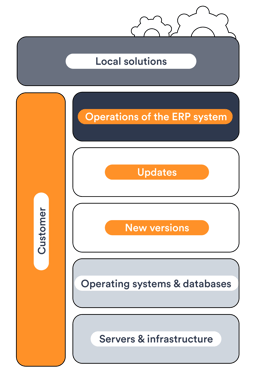
An on-premises solution means that the system is installed on the customer's own infrastructure. The customer is responsible for ensuring the correct licensing of all necessary equipment and operating it correctly. With this solution, it is customary to buy the license and hosting equipment and pay maintenance regularly or rent the license and hardware at a monthly price.
Upgrades and new functionality must be carried out by the customer, or these services can be bought from others. The usual solution is to purchase additional capacity or functionality when needed. It is common to have a subcontractor who takes care of the maintenance and management of the system, but this is often a different supplier than the system supplier.
This system choice is still common among some larger companies and others who have particular challenges related to system functionality.
Cloud Solution

A cloud solution is not a precise concept since there can be several different architectures and ways of implementing these systems. A common understanding is usually that the provider takes care of the operation of the system and places it in a cloud solution. This can be a public cloud (as Azure or AWS), a local cloud provided by the supplier or something that may be more reminiscent of a traditional ASP – environment, such as salesforce.com.
The system provider will often also ensure that all infrastructure is in place, licenses are sufficient, etc. In addition, updates and new versions are usually made "available" to the customer, but they must involve themselves in the actual upgrade and pay for the consulting hours connected to the upgrade. In terms of price, it is common for the service to be divided into 3 different parts:
- License cost: either as rental costs per month or buy the licenses and pay a maintenance cost per year. This provides access to updates.
- Operation cost: a fixed fee per month that includes infrastructure, licenses and databases to operate the system.
- Upgrades and changes to the system: there is no problem with incorporating this into the fixed cost, but the usual way is to keep it out or include it on a "time and materials" basis. The main reason is that the supplier cannot predict how costly future upgrades will be.
Software as a Service
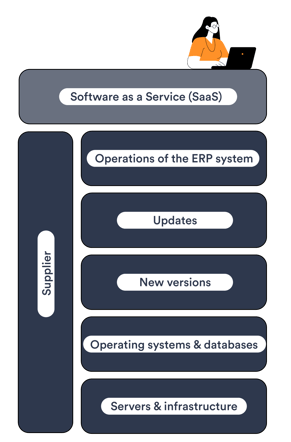
Software as a Service (SaaS) is a delivery form where the supplier takes all the responsibility for the system being up to date and operating correctly. This means that the customer's task is limited to only learning how to use the system; everything else is the supplier's responsibility.
How and when upgrades are executed varies between different SaaS systems. Some systems run regular version upgrades, while others collect them for larger releases. Some take down the system while upgrading; others can do upgrades while the system is running. In most cases, the supplier is responsible for implementing and testing the upgrades and maintaining the security and functionality of the system.
- The regular cost is often a monthly "per-user" subscription fee. This means that costs such as servers, other licenses, future upgrades, amendments to comply with legislative changes, etc. will be included in this subscription cost.
How to compare the different options?
At first glance, it may seem that it's cheaper to do everything yourself, but the reality may be different. An illustrative way of highlighting the differences in the various system delivery models is done by The Software Report¹.
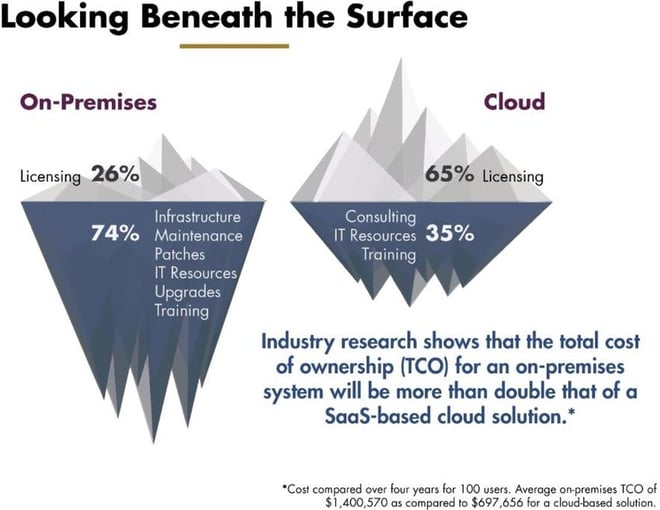
The bottom line is that although the license costs for SaaS systems may seem high, they also represent a much larger proportion of the actual total cost. The exact figures will vary between systems, so always try to find the total cost, including both internal and external costs - now and in the future.
Let's give you some specific aspects to consider.
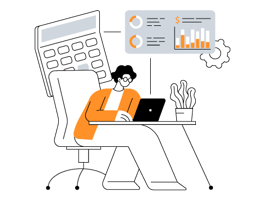
Technical debt
Technical debt is a term used to try and “put a number” on the challenges faced by companies postponing making decisions (and investments) regarding proper systems solutions. By keeping outdated systems, companies also miss out on new effective ways of working. Technical debt is the amount of investment you must make to reach today’s expected level of system support. That investment can consist of many things, such as: new licenses, consultancy costs for an upgrade project, training, new infrastructure, new systems to cover new ways of working, etc. This number is difficult to calculate and therefore often not prioritized by many management groups and boards. Thus, the cost, risk and consequences can be very high when you first decide to do something.

Upgrades
Imagine the authorities changing the VAT rules. Who is responsible for the system upgrade needed for the new change? The usual issue is whether the operation model itself ensures continuous upgrading. The difference between the various systems is how the cost associated with the upgrades becomes visible to the customer. SaaS solutions upgrades are included in the subscription price. The cost of upgrades must be negotiated with the supplier for the other system solutions. Some systems also offer major version upgrades. This is often more than a technical upgrade, typically including new or improved functionality.
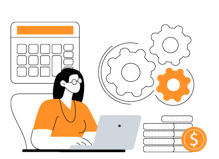
Internal Administration Cost
How much of the time spent on IT support really can be contributed to your ERP system? The internal administration cost of managing a system is an element that is easy to forget, but which can be considerable. It's easy to count the hours that the suppliers have invoiced, but how much time is spent on internal coordination of suppliers, internal testing, planning, follow-up, etc. Again, this applies to both cloud solutions and local solutions.

Licenses and Hardware
If you're considering managing your system's infrastructure yourself, licenses and hardware are one cost element to have in mind. Both ongoing charges and depreciation costs on the investments need to be included. Written-down hardware is not free; it still needs to be operated. A future hardware upgrade must be included in the system cost estimate.

Total Cost over Time
One important thing for many in the decision-making process is the actual financing, liquidity, and predictability of the investment. It's challenging to set this up without having the exact numbers on each item. Still, there are sometimes significant differences in the accrual of costs. The total cost over time will vary based on the different delivery models. Any support agreement with user support and continuous training must also be included to show an accurate picture when doing this calculation.
Cost and time – how to make the right decision?
That is the big question, and it may not always be possible to put a value on all the different cost elements that we have mentioned. This is the important work you have to do when comparing systems is to get the most accurate picture possible of the following cost elements:
| Cost Elements | Description |
|---|---|
| Implementation | The actual implementation project |
| Yearly Rental Cost | For SaaS delivery and some cloud deliveries |
| License Purchase | Often required at the start of the contract |
| Maintenance | Yearly maintenance cost after license purchase |
| Support Agreement | System support for users |
| Hardware and Infrastructure | Investment and depreciation for on-premises solutions or shared/hybrid-solutions |
| Operation of the Cloud-Service | Cost for the operation of the system in the cloud |
| IT Support | For on-premises solutions and shared/hybrid solutions |
| Upgrades | Regardless of the mode of operation you choose |
| Larger Releases/System Upgrades/Versions | Major upgrades. For cloud solutions and on-premises installations, this is usually done at least every 3 years |
| Internal Resources Cost | How much time is spent on testing, coordinating, monitoring, and managing the solution? |
| User Training | The time and resources used to train your employees |
| Uncertainty | Costs that are difficult to place. Can be added as a percentage of the total |
Suppliers should be able to give a precise number or estimate for many of these elements. Keep in mind that the monthly price is not the whole picture. All the other aspects concerning the system delivery need to be fully considered to achieve a proper comparison.
Other relevant questions that can affect the cost of managing the system that you should ask:
- How will the system handle changes in local laws and regulations? Who updates the solutions, how is this done and what does it cost to stay up to date?
- Who is responsible for security in the solution? Technical security, updated operating systems, backups, etc?
- How should the system be kept current and up to date? Who should do what and how often should the system be updated? What is included in the price and what must be ordered and paid for separately?
- What if the company grows a lot and new users must be added to the system? How do you ensure that the system has the capacity, remains stable and that the performance is just as good?
- What happens if you reduce the number of users of the system? How long will you have to notify the supplier in advance and what costs could be associated with the change? (or are you committed to paying for the original number of uses for longer than you need to?)
- How efficient is the implementation process? Are there templates and predefined processes in place, for example, country account plans and reporting requirements, or does everything have to be built from scratch? How long will it take, and what is the cost to your business of this delay?
If you can objectively assess and quantify your options and find a system and a supplier that you believe meets the functional requirements of your company, then you are closer to being able to make a well-informed and more predictable choice.
|
Contact RamBase today and have a no-obligation conversation about how we can solve your system challenges.
|









.png?width=214&name=Odd-Magne-1500x1500px%20(1).png)